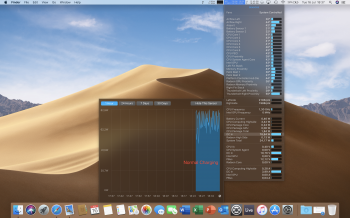I bought a usb c power meter and I did an experiment.
I noticed that with Apple's included usb-c cable charging is not stable ☹️.
As you can see in the screenshots I took.
In stage 1 I charged with the usb-c power meter between the Macbook and charging cable. You can see that I charge with a stable power input sitting at ~82w.
In stage 2 I charged normally and the power input is jumping up and down with a lower overal wattage.
The question is why this weird behaviour?
-I think that Apple's included usb-c charging cable is not able to keep up charging with full power.
-Buying a 100W rated usb-c/thunderbolt cable will charge with full potential and charging will better.
Conclusion: To charge a 15" MBP the fastest with full power you need to buy a 100W rated cable.
Shame on Apple to not include a better charging cable. They sell a Belkin thunderbolt 5A cable with support 100W for a higher price than a normal charging cable.
Give your opinion on why Apple does this. Is this a normal behaviour or not? Are there more people who are seeing this also? Im using iStat Menus btw.
Seems for me that it will be also safer to charge with a stable current for the batteries than swinging power input.
I noticed that with Apple's included usb-c cable charging is not stable ☹️.
As you can see in the screenshots I took.
In stage 1 I charged with the usb-c power meter between the Macbook and charging cable. You can see that I charge with a stable power input sitting at ~82w.
In stage 2 I charged normally and the power input is jumping up and down with a lower overal wattage.
The question is why this weird behaviour?
-I think that Apple's included usb-c charging cable is not able to keep up charging with full power.
-Buying a 100W rated usb-c/thunderbolt cable will charge with full potential and charging will better.
Conclusion: To charge a 15" MBP the fastest with full power you need to buy a 100W rated cable.
Shame on Apple to not include a better charging cable. They sell a Belkin thunderbolt 5A cable with support 100W for a higher price than a normal charging cable.
Give your opinion on why Apple does this. Is this a normal behaviour or not? Are there more people who are seeing this also? Im using iStat Menus btw.
Seems for me that it will be also safer to charge with a stable current for the batteries than swinging power input.




